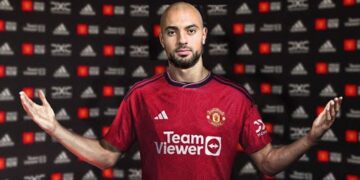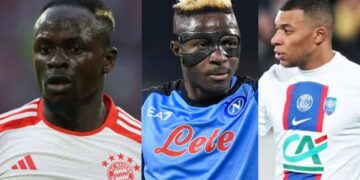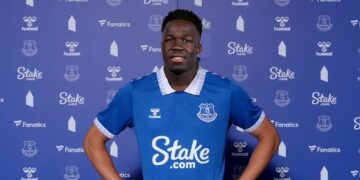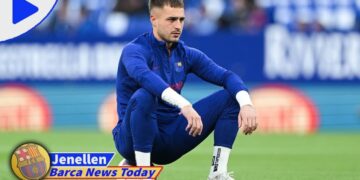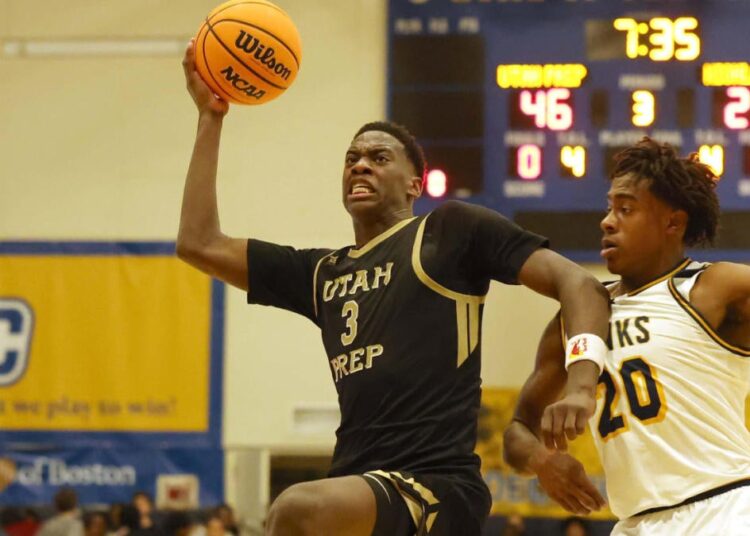We can never predict with certainty how a 17-year-old phenom’s career will pan out, but I can tell you this: Smart people who dedicate their lives to scouting hoops and building basketball teams at the highest level in the world believe that AJ Dybantsa has a chance to one day lead the NBA in scoring. Furthermore, no shortage of NBA executives see Dybantsa’s mental approach to the game, athleticism and intuitive playmaking skills as a genuinely rare combination, putting him in a class with few other prospects over the past 10-plus years.
There’s a term for these types of guys: franchise player.
Let’s check in around 2031 and see if that’s where he’s at. Point is, Dybantsa’s a bona fide star already and his college decision will dictate a meaningful portion of the narrative for the 2025-26 season.
He could have played at Kansas or North Carolina, two blue bloods and the landing spots for some of the best basketball players in history.
He could have played at Alabama, which turned Brandon Miller into a top-three pick and has been one of the best programs of the past four seasons.
He could have played anywhere.
He’s going to play at Brigham Young University.
North Carolina pitched him a vision of being the next all-time scoring superstar to wear Tar Heel Blue, following in the footsteps of Michael Jordan, Vince Carter and Jerry Stackhouse. They referenced how Zion Williamson’s net worth skyrocketed by choosing to play at Duke instead of Clemson and what one season at a blue blood did for his career in advance of being drafted by the New Orleans Pelicans, including a $50 million shoe deal before ever playing an NBA game.
Alabama had a long-standing connection: Crimson Tide assistant Preston Murphy coached Dybantsa at the grassroots level previously, and that seemingly gave the Tide a real shot, dating back years. Last week, the stakes felt upped when Dybantsa’s father, Ace, decided to attend the Alabama-North Carolina game on his own, without his son in attendance. In reality, Dybantsa’s decision was in. He signed a national letter of intent with BYU on Nov. 20, sources said. (This isn’t sitting well, after the fact, with Alabama and North Carolina.)
How did a program that was in the WCC practically 15 minutes ago wind up landing the No. 1 player in the Class of 2025? Is it about the money? To an extent, yes, but it turns out that BYU, North Carolina and Alabama were all able to meet the asking price, which was approximately $5 million, according to sources at schools on Dybantsa’s list of finalists. It’s considered the largest deal for any college basketball player ever. The primary deal ($5 million) is directly from BYU’s collective, according to Leonard Armato, Dybantsa’s business adviser.
“The money for every [school] was the same,” Armato, told CBS Sports. “The decision wasn’t a money decision as much as it was a culture fit, a decision for the family, basketball, all those things that should be the determining factors. There was a certain money threshold, but once you got to that, it was about ‘How comfortable do I feel for me as a basketball player and my family.'”
Armato is a former NBA agent who famously represented Shaquille O’Neal and helped Shaq build out a massive brand during his time as a player. Dybantsa does not have an agent and is primarily advised by his parents, Ace and Chelsea, in addition to Armato.
Dybantsa also has deals with Red Bull and Nike.
“They’re substantial,” Armato said of the Nike and Red Bull deals, though he didn’t want to provide exact numbers. It’s believed those two deals combine for at least another $1 million for Dybantsa. In fact, Armato said that although the Red Bull deal runs through Dybantsa’s first year of college, the Nike contract ends next June, meaning Dybantsa will be on the open market to negotiate again five months before he ever plays for BYU, so his next shoe-company deal will be even more, as the hype heading into 2025-26 increases.
“His deal will be up before he goes to college and he will be a free agent in the athletic footwear market,” Armato said.
With this much earning potential, Dybantsa never had the urge to play for a blue blood and be the next blue-chip guy to add to a wall in a team facility of players drafted into the NBA. Program prestige didn’t register with him; BYU was the leader for months.
In choosing BYU, Dybantsa is staying local in this sense: The Massachusetts native is spending his final year of high school at Utah Prep, a move that also came with significant financial benefits for the Dybantsa family. It’s fair to say no basketball player has been paid more to play hoops before ever stepping on a college court than Dybantsa, but that is the era we are now in.
It’s also not a stretch to say had BYU not hired Phoenix Suns lead assistant Kevin Young in April, Dybantsa could be going to Alabama or North Carolina. Dybantsa immediately became the top priority for Young, who coached Kevin Durant, who is Dybantsa’s favorite player. Young was also on a fast track to being an NBA coach, but opted against that lifestyle in an effort to coach fewer games and be on the road less so he could be around his family more.
He brings pro connections and credibility in a way that resonated heavily with the Dybantsa family.
“A lot of it had to do with the style,” Armato said. “Kevin Young comes from the NBA and they run NBA-style practices and NBA-style offense and they pattern their play after the NBA.”
BYU having multi-billionaire Ryan Smith as a booster (he owns the Utah Jazz and the new NHL franchise, the Utah Hockey Club) also helped significantly. Danny Ainge (who was the GM of the Boston Celtics as Dybantsa emerged as a special talent in New England) and Smith, both members of The Church of Jesus Christ of Latter-day Saints, were the key players in getting Young hired at BYU and subsequently that influence was a factor in Dybantsa’s road to picking the Cougars.
In addition to Young’s NBA background, Dybantsa himself said Tuesday that BYU’s unique campus culture and rules, with its honor code, was an alluring factor, not a deterrent. He wants to go somewhere where it will be almost entirely business. Not many (any?) uber-talented basketball players from Massachusetts have ever opted into playing at a Mormon university, making this story all the more compelling.
“There’s not as many distractions,” Armato told CBS Sports. “He’s not a party kid, he’s not interested in distractions. He wants to play basketball, have his family and keeps to himself. He’s articulate and a confident young man, but he’s not an outgoing party person where he’s got to be in the clubs all the time.”
It’s a fascinating development for college basketball that BYU is going to have this guy on its campus and potentially being the face of the sport a year from now. It’s not unusual for top-rated prospects to go to uncommon destinations but the outcomes, from a college hoops perspective, don’t always lead to huge team success. (Recent examples, of varying results, including Cade Cunningham to Oklahoma State, Ben Simmons to LSU, Anthony Edwards to Georgia.)
We’ll see how things change, or don’t, in the coming years as the House case settlement stands to impact the way NIL collectives are run, but the big takeaway from this is: If you’re going to recruit top-five players, you need to be able to rally millions of dollars to pay them in college basketball moving forward. This is the new world, and Dybantsa is going to serve as the example moving forward. He’s a revolutionary prospect from an earnings perspective. We’ll find out next year if he’s a revolutionary player, the type who’s worth the wait, hype … and money.
Tuesday night’s Jimmy V Classic at Madison Square Garden featured a laugher of an undercard with No. 1 Tennessee casually dismissing Miami 75-62 to improve to 9-0. The Volunteers have won all their games by an average of 25.2 points, each one by double digits. I’m glad I got to see Rick Barnes’ team in person, reinforcing what I believed going in: Tennessee is a title contender, and will remain so, because of the outstanding leadership of Zakai Zeigler and the instant-offense of North Florida transfer Chaz Lanier (19.1 ppg, 48.6 3-point FG%).
In the nightcap, a fun one: Arkansas 89, No. 14 Michigan 87.
The Razorbacks came back from down 15 and held off a surging Michigan that may well have won the game if it was 41 minutes instead of 40. In getting the win, John Calipari has notched his first notable victory of his Arkansas tenure. I think DJ Wagner (16 points, five assists) might be coming into his own. The Wagner-Boogie Fland backcourt combination is probably going to determine how good this team can be.
And for Arkansas to work a 33-point flip in this game (from down 15 to up 18, a 59-26 half-over-half run) was highly encouraging. It was a fun outing for the Hogs in the program’s first game at Madison Square Garden since 1997. Arkansas’ athleticism and speed is where they pose the biggest threat, being able to juice the game, induce loose balls and create chaos with deflections.
“We haven’t even touched what we’re going to be,” Calipari said afterward.
By that he means Arkansas has only had two practices with everyone healthy to this point. But Calipari was loose and certainly feeling himself after the win.
“It’s going to be one of those years. I’m looking forward to it,” Calipari said. “What I did at this time in my life, in my career, this was perfect. First page in the first chapter of the new book and it’s an adventure and I’m going to have fun and enjoy it.”
Let’s expand out beyond the results of these two games. The wins added to the SEC’s nonconference supremacy this season. The 16-team league is building out one of the best out-of-league track records we’ve ever seen. The Southeastern Conference is 127-19 as of Wednesday, which equates to an .869 winning percentage. An incredible number. It has approximately three dozen wins in road or neutral environments, far outpacing all other conferences. No team in the league has four losses yet, and only South Carolina has three. There are seven undefeateds remaining; three of them are in the SEC (Tennessee, Florida, Oklahoma).
Against ranked competition, the SEC is 16-8, which is the most wins in non-league play by any conference ever.
Uh, it’s only Dec. 11.
Half the SEC registers as a Quad 1 result regardless of game location (the quadrant designation adjusts depending on if you’re the home team, road team or on a neutral), but that basically means that eight of the conference’s 16 schools rank top-25 in quality. (Nine, in fact, are in this week’s AP Top 25.) It gets even sillier: Every team except South Carolina is Quad 1 or Quad 2, which is going to lead to the SEC having a record-setting amount of teams with Quad 1/2 results, with some teams logging at least 25 such games.
This is all headed to the league sending at least 10 teams to the NCAA Tournament — the math with math and this is a mortal lock at this point — with 11 and even 12 on the table.
Calipari said he was looking at the SEC recently, going up and down the league and wondering if there was a team or two that would be the weakest spot to pick off a victory.
“Do we have some wins in the league, and then I start thinking, are we the win?” he said. “There are no wins, I can go up and down the league and tell you, they’re telling you this is like SEC baseball now, where it doesn’t matter who you play, you can lose.”
To think, this conference averaged 3.75 NCAA bids from 2009-2016. Now it could land triple that number in 2025. We’ve got less than three weeks to go before nonconference play wraps, but it would take a catastrophic turn for the 2024-25 SEC not to wind up as one of the best single-season conferences in the sport’s history.
@ me
Find me on Bluesky or X/Twitter and drop a Q anytime.
This is a tough one. There are almost 10 guys under consideration right now, including most of Kentucky’s regular starting lineup and someone I saw up close Tuesday, Tennessee’s Chaz Lanier, who has been awesome. (EvanMiya.com’s algorithm says the most productive SEC transfer to this point is Amari Williams at UK.) This is subject to change by this weekend, but maybe Sean Pedulla at Ole Miss is the most valuable. Averaging 14.0 points, 4.0 rebounds, 3.6 assists, 2.3 steals and 1.4 turnovers for an 8-1 team, Pedulla is shooting 44% from 3-point range and 88.9% from the foul line.
If Purdue can maintain its top-10 status in 3-point accuracy (its eighth currently) and Braden Smith holds his claim to being a top-three point guard (he is currently), then Purdue can definitely make another deep tourney run. To me, “deep tourney run” means the Elite Eight or further. Yes, that is on the table again for the Boilers, even despite a lack of proven interior defenders.
This question is about Dan Hurley and in reference to something I wrote while in Maui. I do think Hurley’s sideline animations are, broadly speaking, good for college basketball. He was over the top in Maui, but the fact is UConn’s a blue blood, Hurley’s a great coach with a penchant for some volcanic activity, and that is going to bring attention to him, his program and the sport. He treats his players well, he’s self-deprecating and sarcastic all the same, and if his outbursts are going to cause some folks to root against UConn, that’s not a bad thing. It draws interest. If he goes over the line, I’ll call him out for it, but I want more color and interesting people in the game, not less. Coaches muzzle themselves too much as is.
As of Wednesday, Kansas’ 3-point rate is 321st, which is worse than KU’s previous six-year average: 278th. Bill Self has had a team rank top-100 in 3-point rate just once, 2017-18, and that team was merely 84th. It is surprising that arguably the best coach in the game has never let his teams unleash consistently from deep. He seemingly has the cast to change it this season, and yet: just 20.6 per game. Would love to see how things change if that were to bump up to 25. It’s time to loosen the governor on Zeke Mayo, AJ Storr and Rylen Griffen.
Are we forgetting just how good Jason Richardson was? Please tell me people aren’t forgetting how good Jason Richardson was. A second team All-American, Richardson won a national title in 2000, was a top-five NBA pick, two-time Slam Dunk champion (when that meant something!), played 14 seasons in the NBA and averaged 17.1 points, 5.0 rebounds and 2.7 assists. He was maybe one of the 10 best athletes in college basketball between 1996 and 2005, and damn if there weren’t a lot of great athletes in that era. Jase Richardson’s a nice player, but I’d put his ceiling markedly lower than his father’s.
Good question, but hard to answer because we don’t truly know the deals a lot of these players signed. There are a number of guys rumored to be upward of $800,000 in NIL deals who are falling way short at the moment, though. It’s a new dynamic in the sport and a heavy thing for players and coaches alike to have to deal with behind the scenes as seasons play out differently than the rosy picture that was painted after some of these portal commitments were made in the spring.
Norlander’s news + nuggets
• Shoutout to a pair of Ivy League schools that notched major victories Tuesday: Brown ended Rhode Island’s undefeated season by winning 84-80 in 2OT to improve to 7-3. Cornell is also 7-3 after flying across the country to upset Cal 88-80 and land its fourth road win. Between those two, plus Princeton (8-4), Columbia (10-1) and Yale (5-5 but ranked highest in the metrics), the Ivy League might have one of its best seasons of the past 30 years.
• The Mountain West added UC Davis in all sports but football on Tuesday, with the link-up coming in 2026. That brings the conference to 10 basketball teams moving forward (UC Davis and Grand Canyon don’t play football), but the league is undoubtedly being downgraded due to the revival of the Pac-12 (which is still in search of one more member in football to stabilize its future).
• In other conference news: The WCC is suing Grand Canyon! GCU backed out on its WCC commitment and now there’s money to be had and lawyers to be paid.
• Rutgers (6-4) held on to beat Penn State 80-76 at home on Tuesday. It was a necessary win for the Scarlet Knights if they want to have hope at building an at-large résumé. Dylan Harper had 24 points, 12 rebounds and five assists. He’s the Real Deal.
• West Virginia was off to a nice start (7-2), but the news that Tucker DeVries is out indefinitely with what’s being described as an “upper body injury” severely limits the Mountaineers’ outlook once Big 12 play begins on Dec. 31 at Kansas.
• More injury news: Loyola Chicago will be without guard Jayden Dawson for a month-plus due to an ankle injury, Sports Illustrated reports. Dawson is a key cog and LUC (8-0) could be an at-large team this season, but no Dawson is a curveball.
• Maryland’s Derik Queen — a freshman — has a case as one of the 15-or-so best players in the country through the first six weeks of the season. Queen (17.5 ppg, 8.7 rpg) put up a personal-best 26 points along with 12 rebounds and two blocks vs. Purdue over the weekend. Some thought Queen was destined to be a two- or three-year traditional big in college, but that’s not his trajectory at all right now.
• Matt Brown’s consistently reliable Extra Points newsletter tackles a topic this week that deserves annual scrutiny: Athletic directors shouldn’t be serving on selection committees, or at the very least they shouldn’t comprise the majority of the voting delegation.
• Kentucky plays Colgate on Wednesday. Why? A former chemistry professor who grew up in Kentucky and went on to work at Cornell forged a bond, with his love of basketball leading to this game to be played. Pretty cool back story, albeit bittersweet.
• Under-the-radar NBA prospect I really like: San Diego State’s Miles Byrd. Is averaging 12.3 points, 5.1 rebounds and will be the team’s MVP this season as SDSU aims to have an NCAA Tournament-quality program for the seventh time in eight seasons under Brian Dutcher.
• Here’s your heads-up that one of Tennessee, Auburn, Iowa State, Duke, Kentucky, Marquette, Alabama, Gonzaga, Florida, Kansas, Purdue or Oregon will win the 2025 national championship. Those are the top 12 teams in the Week 6 AP Top 25. A prophecy must be fulfilled. I wrote about the phenomenon in the Court Report last year.
• This is from college football, but I have to share it. Check out Arizona State coach Kenny Dillingham and what he had to say about guiding his players through the transfer portal process … in the middle of a push to the CFP. To hear a coach speak like this on the record is astounding, and yet it shouldn’t be. If more coaches approached the process this way, they’d have a lot more success with transfer (and/or not losing players).
Read the full article here







